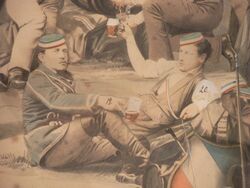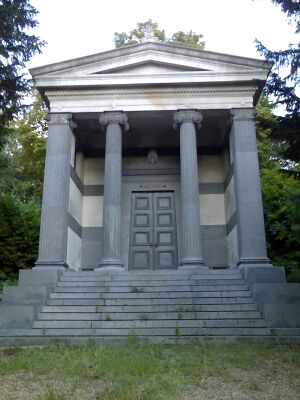لودفيغ موند
Ludwig Mond | |
|---|---|
 پورتريه لودڤيگ موند، بريشة سولومون جوسف سولومون، ح. 1909 | |
| وُلِدَ | March 7, 1839 |
| توفي | December 11, 1909 Regent's Park, London, England |
| الجنسية | ألماني، British by naturalisation |
| الجنسية | British |
| المدرسة الأم | جامعة ماربورگ جامعة هايدلبرگ |
| اللقب | الاستخدام التجاري لـ عملية سولڤاي اكتشاف كربونيل النيكل Mond gas Mond process |
| الزوج | Frida Löwenthal |
| الأنجال | Robert Mond Alfred Mond, 1st Baron Melchett |
| الجوائز | Grand cordon of the Order of the Crown of Italy Fellow of the Royal Society (1891) |
| السيرة العلمية | |
| المجالات | كيميائي |
| الهيئات | Brunner Mond & Company Mond Nickel Company |
| المشرف على الدكتوراه | هرمان كولبه روبرت بونسن |
الدكتور لودڤيگ موند Ludwig Mond (عاش 7 مارس 1839 - 11 ديسمبر 1909)، كان كيميائي وصناعي ألماني المولد[1] حصل على الجنسية البريطانية. He discovered an important, previously unknown, class of compounds called metal carbonyls.
. . . . . . . . . . . . . . . . . . . . . . . . . . . . . . . . . . . . . . . . . . . . . . . . . . . . . . . . . . . . . . . . . . . . . . . . . . . . . . . . . . . . . . . . . . . . . . . . . . . . . . . . . . . . . . . . . . . . . . . . . . . . . . . . . . . . . . . . . . . . . . . . . . . . . . . . . . . . . . . . . . . . . . . .
التعليم والسيرة
Ludwig Mond was born into a Jewish family in Kassel, Germany. His parents were Meyer Bär (Moritz) Mond and Henrietta Levinsohn. After attending schools in his home town, he studied chemistry at the University of Marburg under Hermann Kolbe and at the University of Heidelberg under Robert Bunsen but he never gained a degree.[2] He then worked in factories in Germany and the Netherlands before coming to England to work at the factory of John Hutchinson & Co in Widnes in 1862. He worked in Utrecht for the firm of P. Smits & de Wolf from 1864 to 1867 and then returned to Widnes. Here he formed a partnership with John Hutchinson and developed a method to recover sulphur from the by-products of the Leblanc process, which was used to manufacture soda ash.[3]
In 1872 Mond got in touch with the Belgian industrialist Ernest Solvay who was developing a better process to manufacture soda ash, the ammonia-soda or Solvay process. The following year he went into partnership with the industrialist John Brunner to work on bringing the process to commercial viability. They established the business of Brunner Mond & Company, building a factory at Winnington, Northwich. Mond solved some of the problems in the process that had made mass production difficult, and by 1880 he had turned it into a commercially sound process.[2] Within 20 years the business had become the largest producer of soda ash in the world.[3]
Mond continued to research new chemical processes. He discovered nickel carbonyl, a previously unknown compound and the first-discovered in the class of metal carbonyls, which could be easily decomposed to produce pure nickel from its ores through the Mond process.[4] He founded the Mond Nickel Company to exploit this. Ores from nickel mines in Canada were given preliminary enrichment there and then shipped to Mond's works at Clydach, near Swansea, Wales for final purification.[3]
He was one of the first industrialists of his time who offered his employees paid holidays and fringe-benefits.[5]
التكريم
Mond supported scientific societies and, with Henry Roscoe, helped to expand the small Lancashire Chemical Society into the nationwide Society of Chemical Industry of which he was elected president in 1888.[6] He was elected to the Royal Society in 1891.[7] Abroad, he was elected to membership of the German Chemical Society, the Società Reale of Naples, and the Prussian Akademie der Wissenschaften. He received honorary doctorates from the universities of Padua, Heidelberg, Manchester and Oxford and was awarded the grand cordon of the Order of the Crown of Italy.[3]
He was a benefactor to a number of scientific organisations including the Royal Society, the Italian Accademia dei Lincei and the Royal Institution of Great Britain. In his will he left bequests to the town of Kassel and to a number of Jewish charities. In his later years he had built up a collection of old master paintings and he left the greater proportion of these to the National Gallery, London.[3] His wife left a large collection of materials relating to German literature to King's College, London.[8]
The Royal Society of Chemistry awards the Ludwig Mond Award in his honour.[9] A statue of him, designed by Édouard Lantéri (1912), stands in front of the former Brunner Mond offices in Winnington, flanked by a statue of Brunner.[10] Another statue of Mond is sited across from the Mond Nickel Works in Clydach, Wales, and is a Grade II listed structure [11]
العائلة ومعلومات شخصية
In October 1866 Mond married his cousin Frida Löwenthal (1847–1923) in her native town of Cologne. They soon moved to England and had two sons, Robert and Alfred. In 1880 he took British nationality. While he was establishing his business the family lived at Winnington and in 1884 they moved to London. From the early 1890s on, he spent most of his winters in Rome at his home there. This home, the Palazzo Zuccari, was first leased and then (1904) bought in the name of his wife's friend Henriette Hertz, who developed it into a study centre for the history of art now called Bibliotheca Hertziana. He died in his London home, 'The Poplars', Avenue Road, near Regent's Park. Although he had never practised any religion he was buried with Jewish rites at St Pancras cemetery where his sons erected a mausoleum. His estate was valued at £1 million.[3]
انظر أيضاً
الهامش
- ^ "Mond, Ludwig". Who's Who,. 59: p. 1241. 1907.
{{cite journal}}:|pages=has extra text (help)CS1 maint: extra punctuation (link) - ^ أ ب خطأ استشهاد: وسم
<ref>غير صحيح؛ لا نص تم توفيره للمراجع المسماةweintraub - ^ أ ب ت ث ج ح خطأ استشهاد: وسم
<ref>غير صحيح؛ لا نص تم توفيره للمراجع المسماةdnb - ^ خطأ استشهاد: وسم
<ref>غير صحيح؛ لا نص تم توفيره للمراجع المسماةnickel - ^ "Society of Chemical Industry - Ludwig Mond".
- ^ "SCI Presidents".
- ^ Salaman, Redcliffe N. (1948). "The Jewish Fellows of the Royal Society: Paper read before the Jewish Historical Society of England, 15th December, 1947". Miscellanies (Jewish Historical Society of England). 5: 146–175. ISSN 2047-234X. JSTOR 29777119.
- ^ خطأ استشهاد: وسم
<ref>غير صحيح؛ لا نص تم توفيره للمراجع المسماةkcl - ^ خطأ استشهاد: وسم
<ref>غير صحيح؛ لا نص تم توفيره للمراجع المسماةrsc - ^ خطأ استشهاد: وسم
<ref>غير صحيح؛ لا نص تم توفيره للمراجع المسماةstatue - ^ "Statue of Sir Ludwig Mond, Clydach, Swansea".
المراجع
خطأ استشهاد: علامة <ref> بالاسم " dnb " المحددة في <references> لها سمة المجموعة " " والتي لا تظهر في النص السابق.
خطأ استشهاد: علامة <ref> بالاسم " eb " المحددة في <references> لها سمة المجموعة " " والتي لا تظهر في النص السابق.
خطأ استشهاد: علامة <ref> بالاسم " kcl " المحددة في <references> لها سمة المجموعة " " والتي لا تظهر في النص السابق.
خطأ استشهاد: علامة <ref> بالاسم " nickel " المحددة في <references> لها سمة المجموعة " " والتي لا تظهر في النص السابق.
خطأ استشهاد: علامة <ref> بالاسم " rsc " المحددة في <references> لها سمة المجموعة " " والتي لا تظهر في النص السابق.
خطأ استشهاد: علامة <ref> بالاسم " statue " المحددة في <references> لها سمة المجموعة " " والتي لا تظهر في النص السابق.
خطأ استشهاد: علامة <ref> بالاسم " weintraub " المحددة في <references> لها سمة المجموعة " " والتي لا تظهر في النص السابق.
<ref> بالاسم " who " المحددة في <references> لها سمة المجموعة " " والتي لا تظهر في النص السابق.للاستزادة
- Cohen, J. M. (1956), The Life of Ludwig Mond, London: Methuen
خطأ لوا في وحدة:Authority_control على السطر 278: attempt to call field '_showMessage' (a nil value).
- CS1 errors: extra text: pages
- Short description is different from Wikidata
- Pages using infobox scientist with unknown parameters
- Articles containing ألمانية-language text
- مواليد 1839
- وفيات 1909
- مؤسسو شركات بريطانيون
- كيميائيون بريطانيون
- كيميائيون ألمان
- زملاء الجمعية الملكية
- يهود ألمان
- يهود بريطانيون
- يهود إنگليز
- علماء يهود
- People associated with the National Gallery, London
- خريجو جامعة ماربورگ
- خريجو جامعة هايدلبرگ
- مهاجرون ألمان إلى المملكة المتحدة
- Burials at St Pancras and Islington Cemetery

